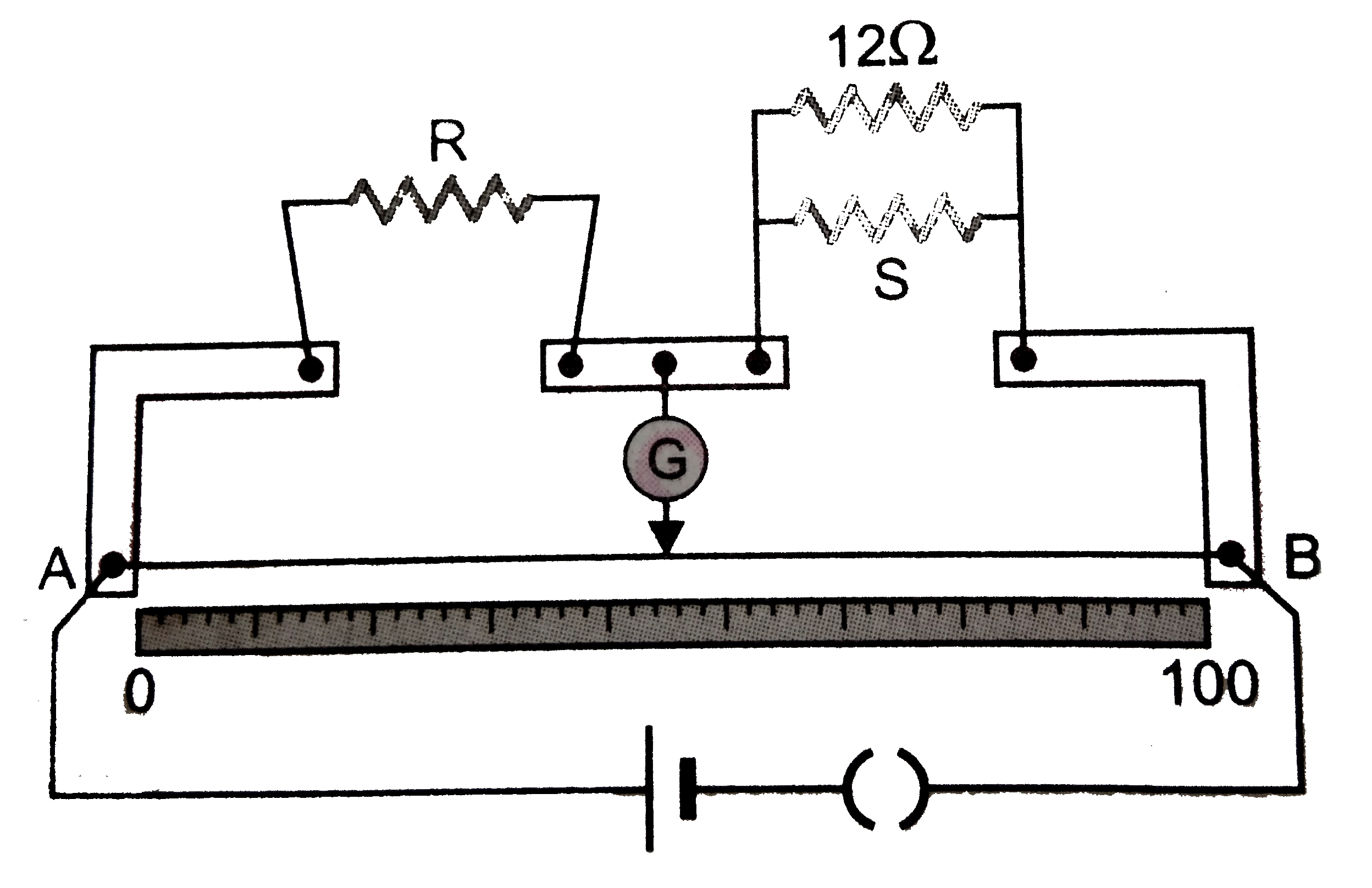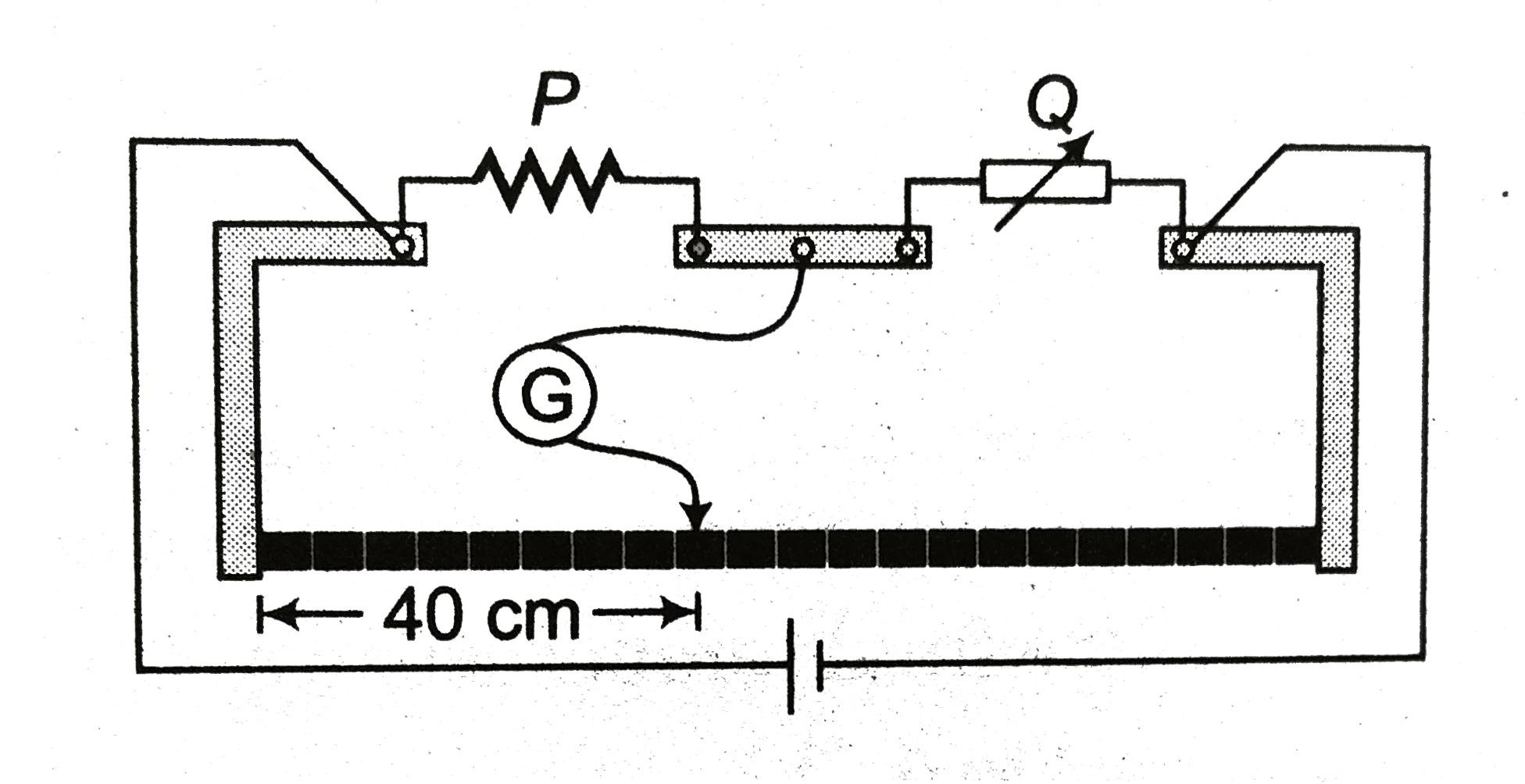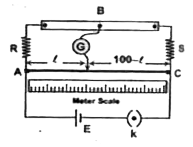Two unkonwn resistances X and Y are connected to left and right gaps of a meter bridge and the balancing point is obtained at 80cm from left. When a 10Ω resistance is connected parallel to X, the balancing point is 50cm from left. The values of X and Y respectively are
40Ω,9Ω
30Ω,7.5Ω
20Ω,6Ω
10Ω,3Ω
The correct Answer is:B
To solve the problem, we need to find the values of the unknown resistances X and Y using the information provided about the meter bridge and the balancing points.
1. Understanding the Meter Bridge Principle:
The meter bridge operates on the principle of Wheatstone bridge. The relationship between the resistances and the balancing point is given by:
XY=L100−L
where L is the distance from the left end to the balancing point.
2. First Balancing Point:
From the problem, when the balancing point is at 80 cm from the left, we can substitute L=80 cm into the equation:
XY=80100−80=8020=4
This implies:
X=4Y(Equation 1)
3. Second Balancing Point with Parallel Resistance:
When a 10Ω resistor is connected in parallel with X, the new equivalent resistance Req of X and 10Ω is given by:
Req=X×10X+10
The new balancing point is at 50 cm from the left, so we can set up the equation:
ReqY=50100−50=5050=1
This implies:
Req=Y(Equation 2)
4. Substituting Req into Equation 2:
Substitute Req from the earlier expression into Equation 2:
X×10X+10=Y
5. Using Equation 1:
From Equation 1, we know Y=X4. Substitute this into the equation:
X×10X+10=X4
6. Cross Multiplying:
Cross-multiply to eliminate the fraction:
10X=X4(X+10)
Simplifying gives:
10X=X2+10X4
Multiply through by 4 to eliminate the fraction:
40X=X2+10X
Rearranging gives:
X2−30X=0
Factoring out X:
X(X−30)=0
Thus, X=30Ω (since resistance cannot be zero).
7. Finding Y:
Substitute X back into Equation 1 to find Y:
Y=X4=304=7.5Ω
Final Answer
The values of X and Y are:
X=30Ω,Y=7.5Ω
The meter bridge operates on the principle of Wheatstone bridge. The relationship between the resistances and the balancing point is given by:
XY=L100−L
where L is the distance from the left end to the balancing point.
From the problem, when the balancing point is at 80 cm from the left, we can substitute L=80 cm into the equation:
XY=80100−80=8020=4
This implies:
X=4Y(Equation 1)
When a 10Ω resistor is connected in parallel with X, the new equivalent resistance Req of X and 10Ω is given by:
Req=X×10X+10
The new balancing point is at 50 cm from the left, so we can set up the equation:
ReqY=50100−50=5050=1
This implies:
Req=Y(Equation 2)
Substitute Req from the earlier expression into Equation 2:
X×10X+10=Y
From Equation 1, we know Y=X4. Substitute this into the equation:
X×10X+10=X4
Cross-multiply to eliminate the fraction:
10X=X4(X+10)
Simplifying gives:
10X=X2+10X4
Multiply through by 4 to eliminate the fraction:
40X=X2+10X
Rearranging gives:
X2−30X=0
Factoring out X:
X(X−30)=0
Thus, X=30Ω (since resistance cannot be zero).
Substitute X back into Equation 1 to find Y:
Y=X4=304=7.5Ω
The values of X and Y are:
X=30Ω,Y=7.5Ω
Topper's Solved these Questions
- BOOK - AAKASH SERIESCHAPTER - CURRENT ELECTRICITYEXERCISE - LECTURE SHEET (EXERCISE-IV LEVEL- II (ADVANCED) (Straight Objective Type Questions))2videos
CURRENT ELECTRICITY
- BOOK - AAKASH SERIESCHAPTER - CURRENT ELECTRICITYEXERCISE - LECTURE SHEET (EXERCISE-IV LEVEL- II (ADVANCED) (Linked Comprehension Type Questions))3videos
CURRENT ELECTRICITY
- BOOK - AAKASH SERIESCHAPTER - CURRENT ELECTRICITYEXERCISE - LECTURE SHEET (EXERCISE-III LEVEL- II (ADVANCED) (Linked Comprehension Type Questions)2videos
CURRENT ELECTRICITY
- BOOK - AAKASH SERIESCHAPTER - CURRENT ELECTRICITYEXERCISE - PROBLEMS (LEVEL-II)27videos
CURRENT ELECTRICITY
- BOOK - AAKASH SERIESCHAPTER - DUAL NATURE OF RADIATION AND MATTEREXERCISE - PRACTICE EXERCISEX42videos
DUAL NATURE OF RADIATION AND MATTER
Similar Questions
Two unknown resistances are connected in two gaps of a meter-bridge. The null point is obtained at 40 cm from left end. A 30Ω resistance is connected in series with the smaller of the two resistances, the null point shifts by 20 cm to the right end. The value of smaller resistance in Ω is
View SolutionTwo unknown resistances X and Y are placed on the left and right gaps of a meter bridge. The null point in the galvanometer is obtained at a distance of 80cm from left. A resistance of 100Ω is now connected in parallel across X. The null point is then found by shifting the sliding contact toward left by 20cm. Calculate X and Y.
View Solution
Knowledge Check
- Question 1 - Select One
When a metal conductor connected to left gap of a meter bridge is heated, the balancing point
Ashifts towards rightBshifts towards leftCremains unchangedDremains at zero
The resistance in the left and right gaps of a balanced meter bridge are R1 and R1. The balanced point is 50cm. If a resistance of 24Ω is connected in parallel to R2, the balance point is 70cm. The value of R1 or R2 is.
View SolutionWhen un known resistance and a resistance of 4Ω are used in the left and right gaps of a meter bridge, the balance point is 50cm. the shift in the balance point if a 4Ω resistance is now connected parallel to the resistor in right gap ______
View SolutionIn a meter bridge, the null point is found at a distance of 40cm from A. If a resistance of 12Ω in connected in parallel with S the null point occurs at 50.0cm from A Determine the value of R and S
 View Solution
View SolutionIn a metre bridge the null point is found at a distance of 35 cm from A. If now a resistance of 10Ω is connected in parallel with S, the null point occurs at 50 cm. Determine the values of R and S.
View SolutionIn a metre bridge, the gaps are closed by two resistance P and Q and the balance point is obtained at 40cm. When Q is shunted by a resistance of 10Ω, the balance point shifts to 50cm. The values of P and Q are.
 .View Solution
.View SolutionIn a meter bridge, the null point is found at a distance of 40 cm from A. If now a resistance of 12 Ω is connected in parallel with S, the null point occurs at 60 cm from A. Determine the value of R.
 View Solution
View SolutionTwo resistances are connected in the two gaps of a meter bridge. The balance point is 20cm from the zero end. When a resistance 15Ω is connected in series with the smaller of two resistance, the null point+ shifts to 40cm. The smaller of the two resistance has the value.
View Solution

